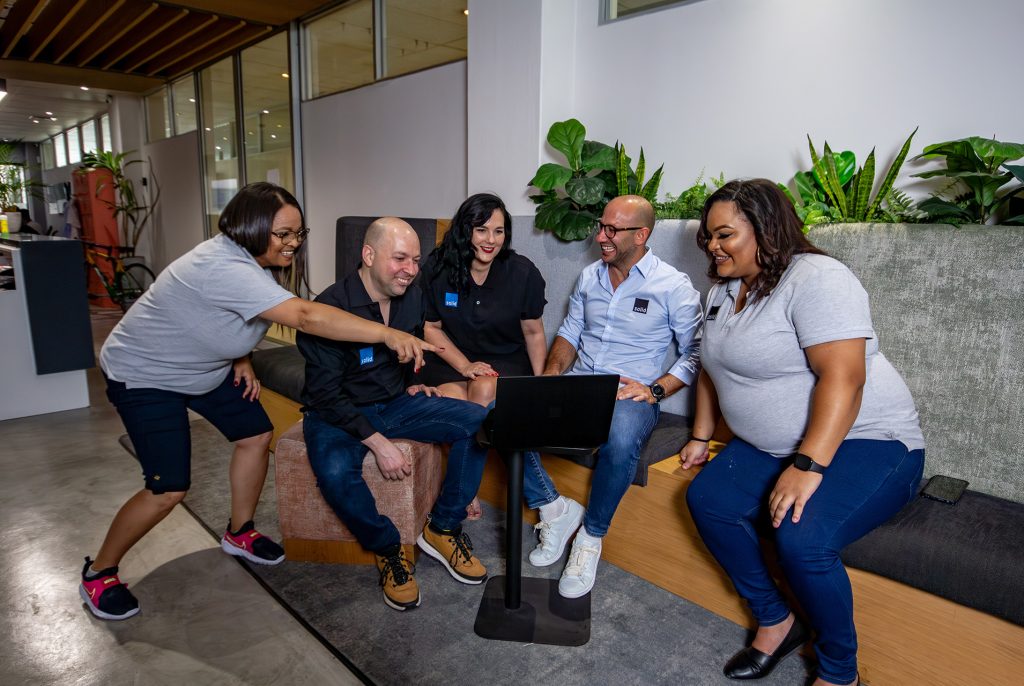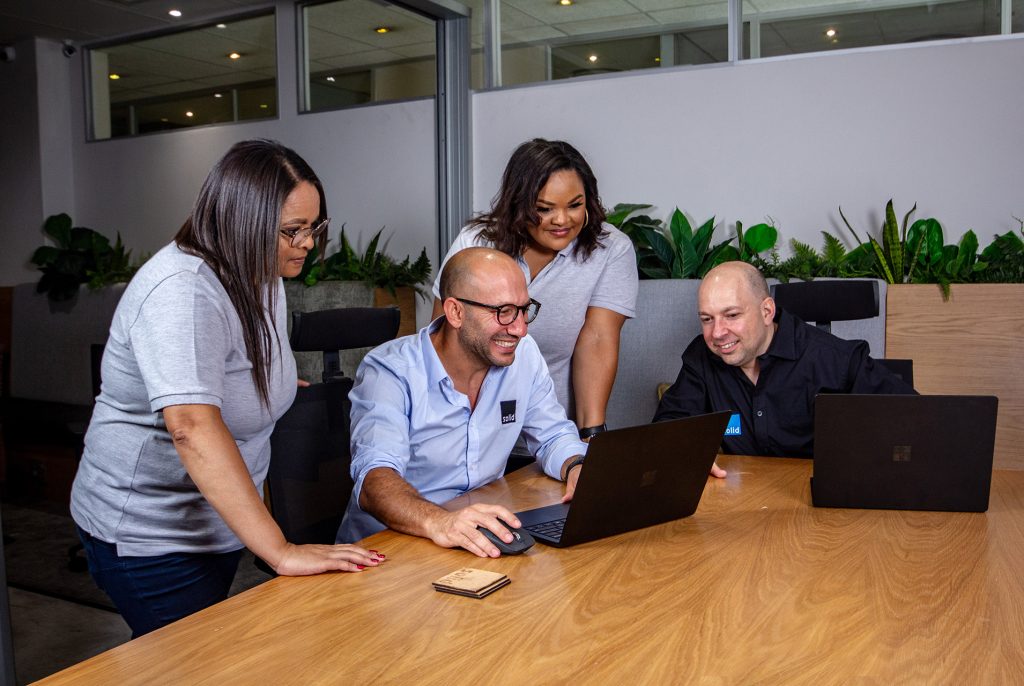
At Solid, we always like to say that we’re human, not robots. With this in mind, we’ve put together a series of articles that show the human side of our day-to-day operations. You’ll get to know the Solid humans who you interact with everyday a little better, gain a better understanding of the impact Microsoft’s modern workplace can have on a business, and see our processes in action.
We’ve spoken to Carolyn from Sales and our Technical Coordinator, Melissa. Now it’s time to hear from one of our most popular IT Pros – Confidence.
A Day in the Life of Confidence Selowa
It’s 7am, and my day is just kicking off. Some people would say it’s too early – that they’d rather be in bed. Me? I like an early start to the day. It’s quiet in the morning, and it means that my shift ends at 4pm, leaving me a bit more time to relax in the afternoon.
I’m in the office today, and I’m one of the first to arrive. I take out my laptop (that magical beast that helps me work from wherever I am), and I log into the apps I’m going to need for my day. I open up the Authy app, since all of the systems I log into need multi-factor authentication (MFA). Authy helps me keep track of all the codes I need to log in with MFA across both my laptop and my desktop, making it so much quicker and easier to keep my login details secure.
AutoTask is our ticketing system, which is basically the heart of our IT support. Every ticket that gets sent to [email protected] comes through AutoTask, and then gets assigned to the team member who will attend to it. So, making sure that I’m signed into AutoTask is one of the first steps of my day.
“Authy helps me keep track of all the codes I need to log in with MFA across both my laptop and my desktop, making it so much quicker and easier to keep my login details secure.”
Once I’m in, I check all the tickets that have been assigned to me. These can range from user setups, to printer issues, to network trouble. But this early in the morning, I work on priority tickets – those alerts and problems that clients may not even be aware of yet, since most of them only start getting to the office at 8am. If there are no pressing tickets that need to be dealt with, then the first hour of my workday usually involves working on the tickets that can be completed quickly, and will save me time later in the day. These are the emails that don’t really need a follow up with the client – it’s just making a small change or adjustment to our monitoring system or adjusting thresholds, and they’re done.
IT Glue is another essential app that we use at SOLID. It’s all about making sure that we have the access to the client credentials and the data on how their systems are setup. Basically, it stores the information that we need to offer exceptional support. But data security is such an important part of everything we do, so IT Glue is also there to help us keep those credentials secure. It makes sure that the right people, and only the right people, have access to the information they need.
“Sometimes I’m lucky and get to train some of them myself, and those are awesome days, because I dig helping new people understand the SOLID way of doing things.”
But that’s not the only thing that IT Glue helps with. It’s where we store our training guides as well, helping us to address client-specific issues that we may not have come across before as individuals, but that our team knows how to handle. There are also guides on SOLID procedures that we should be following. These are all incredibly helpful when it comes to training our new IT Pros. Sometimes I’m lucky and get to train some of them myself, and those are awesome days, because I dig helping new people understand the SOLID way of doing things.
Then there’s N-Central. This is basically one of the cores of our IT support, helping us to troubleshoot client issues and connect to their devices remotely. It helps us to understand exactly what it is that the person on the other end of the line is seeing, so that we can fully grasp the problem that they’re experiencing. Often people who aren’t familiar with technology find it difficult to explain what’s happening, and what problem they’re experiencing. Even those who are familiar with technology often struggle to find the right words to explain what’s going on. It just makes it so much easier to see it for ourselves. And it makes it a lot quicker to fix an issue when we are able to take control, rather than walking a customer who may or may not be device savvy through the steps.
“Often people who aren’t familiar with technology find it difficult to explain what’s happening, and what problem they’re experiencing. Even those who are familiar with technology often struggle to find the right words to explain what’s going on. It just makes it so much easier to see it for ourselves.”
When it comes to our team, connection and sharing of information is so important. There may be some things that I know how to do, or ways that I do things, that others can learn from. And I know that there is a lot that I can learn from them as well. When we’re all in the office together, it’s a bit easier to learn from each other – it’s a matter of leaning over and going, “Hey, you’re doing it that way. Have you tried this?” We also get to have lunch together and catch up on how our lives are going, which helps us to feel properly connected. But our IT pros are split between two offices – Cape Town and Joburg. So even when we are all in the office, we’re not all there. And then there’s the fact that we’re working from our own home offices more than half the time. So we have to find other ways of connecting.
One of the tricks we’ve found that works really well is keeping a meeting open in Microsoft Teams. Everyone’s invited, and we all pop in whenever we need help, feel like we have some time to offer guidance, or just want to chat about how our days are going. Sitting in there and talking through what we’re doing gives us a little bit of that ‘whisper-guidance’ as Michael and Daniel like to call it. The pieces of information and tips on doing things that you tend to pick up when you’re in the same space together. We may not be in the same physical space, but having a virtual space to connect can sometimes work just as well.
“One of the tricks we’ve found that works really well is keeping a meeting open in Microsoft Teams. Everyone’s invited, and we all pop in whenever we need help, feel like we have some time to offer guidance, or just want to chat about how our days are going.”
Over the course of my day, our Dispatcher will send through tickets according to how our schedule’s looking. Some days I’ll deal with as few as 5 tickets, others as many as 20. It all depends on how complex the scenarios are, how much time is needed. One ticket can take practically an entire day to complete, others can’t even be completed in a single day. But on average, I deal with around 15 tickets per day – a mix of longer issues and quick fixes.
By the time the day’s done and I’m ready to pack up and head home, I feel like I’ve accomplished a lot. I don’t know that most people think of IT support as being a job for a people’s person, but I definitely do. I love chatting to customers, connecting with them and with my colleagues. I know that I talk a lot, but I listen too. And I learn. And I really like the feeling that it leaves me with at the end of the day, knowing that I’ve made someone’s day that little bit easier, that little bit better.
Ready to delve into the days of some of Solid’s other team members? We’ve spoken to our Procurement Specialist, our Technical Coordinator and one of our Solid’s Co-Founders about what their positions involve.





